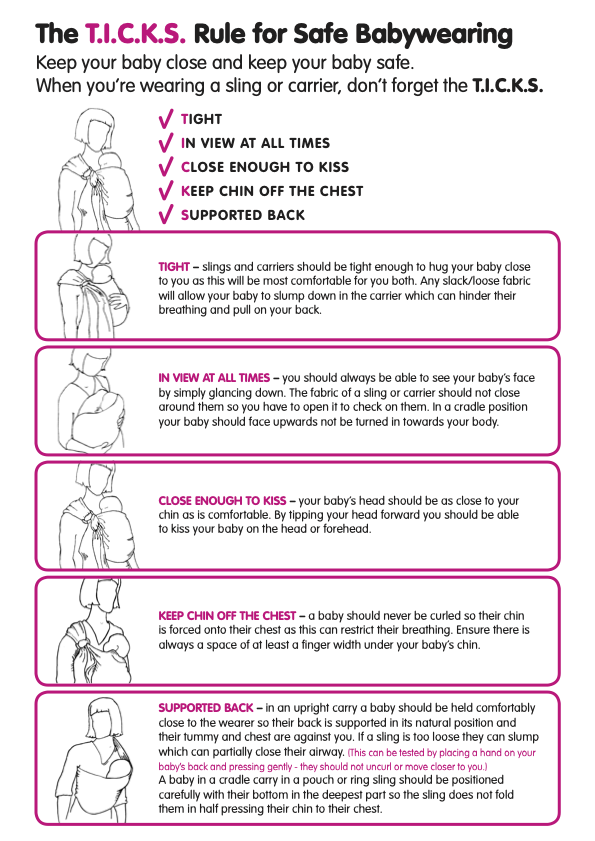Finding a good baby sling that is right for you can feel a little overwhelming. There are so many to choose from; it's not surprising parents get flustered.
We recommend finding your local sling library. They will have a wide variety of slings for you to look at, try on and even take away to trial for a few days. Once you're happy you've found the perfect sling for your lifestyle, you can then invest your hard-earned cash!
You can google 'sling library' or search for your local one on Facebook. Alternatively there is an interactive map on this website (along with lots of useful information): www.slingpages.co.uk
What are the benefits of baby-wearing?
The research into slings is not extensive. However, there are plenty of benefits to wearing your baby in a sling or baby carrier.
Bonding
Physical contact is essential, especially for a newborn. It boosts the flow of oxytocin, known as the 'love hormone' in both parent and baby. In neonatal wards, health professionals encourage Kangaroo Care when a baby is worn skin-to-skin in a sling. Research shows this regulates the baby's breathing, heart rate and supports better temperature control.
Responsive parenting
Being closer to your baby lets you realise they need something more quickly, whether it's feeding, a nappy change or a little chat! A global study, carried out by the World Health Organisation in 2006, found that responsive parenting positively impacts health and development:
- Improved language acquisition
- Fewer behavioural problems and better social skills
- Increased IQ and school achievements.
The other benefit of meeting your baby's needs more quickly is that they will cry less. Crying is often one of the last 'cues' a baby uses to tell you they need something. They use more subtle cues beforehand, such as:
- Turning away from stimulation when they're tired
- Sucking (on anything) when hungry.
Frees up your hands
Life with a newborn flies by, and it can be a struggle to stay on top of all the things you need to do in a day. Wearing your baby in a sling meets their need for closeness and comfort whilst also freeing up your hands so you can put a wash on, do some shopping or take the dog for a walk. Not only that, it's excellent strength training without straining your back!
Fussy babies
There are many reasons your baby may go through a fussy stage when they need to cuddle a little more than usual. A sling can help give them the comfort they need. For example, if your baby suffers from:
Breastfeeding
When out and about, you can breastfeed on-demand with your baby in a sling. You can use an upright or laid-back feeding position and with your hands-free, focus on getting the baby latched on well. It is advisable to try this at home and get comfortable with both the feeding position and sling use before you venture out! The other benefit of the sling is you can breastfeed more discreetly, whenever you wish to!
What are the risks associated with slings?
Once you've bought a sling, the next thing to consider is your baby's safety. The main risk associated with wearing your baby in a sling is asphyxiation. Babies can suffocate in a couple of minutes if their airway is blocked. Two things to look out for:
- Their chin is tucked into their chest; this closes a baby's airway.
- Any fabric from the sling or clothing (yours or theirs) obstructs their mouth and nose.
Other risks include dropping a baby when trying to maneuver them into a sling (this takes a little practice) and overheating.
Overheating is a considerable risk factor for Sudden Infant Death Syndrome (SIDS, formerly known as cot death). Remember that you and your baby will warm up when your bodies are close together. Even if it's freezing outside, your baby will not need lots of big bulky clothing if you carry them in a sling. Snowsuits and bulky coats can not only be a risk factor for overheating, but they can also cause babies to slip down into a less safe carrying position. As with car seats, the advice is to remove these clothes from your baby when in a sling.
Remember T.I.C.K.S
The UK Sling Consortium created a handy acronym to help new parents get babywearing right - T.I.C.K.S. It stands for:
- Tight
- In view at all times
- Close enough to kiss
- Keep chin off chest
- Supported back
It is essential to check your baby regularly to make sure you've ticked all these boxes!
Tight
A tight, well-fitting sling is best for your baby! The sling needs to be supporting your baby firmly. If it is loose, your baby may slump down into the sling, which can limit their ability to breathe.
In view at all times
If you glance down, you should be able to see your baby's face without having to move any part of the sling (or clothing). Try to avoid your baby's facing into your chest, which may obstruct their breathing. Instead, face their head out to one side or slightly upwards.
Close enough to kiss
Sit your baby high enough up your chest that you can tilt your head forward to kiss their forehead without straining your neck or pushing their bottom upwards.
Keep chin off chest
Ensure there is enough space for one finger under your baby's chin when they're in a sling. They should never curl up so tight that their chin is forced down onto their chest, as this can restrict their breathing.
Supported back
In an upright sling, support your baby in a natural position (as if you were cuddling them, holding them below their bottom), so their tummy and chest are flat against you. If the sling is too loose, they can slump down, which risks breathing problems.
You can test if the sling is well-fitting by pressing gently on their back. If your baby uncurls or moves closer to you, the sling needs to be adjusted.
One final tip
A sling should allow you to carry your baby comfortably for longer than if you had them in your arms. You shouldn't feel any aches and pains when carrying your baby in a sling. If you are getting any pain in your neck, shoulders, or back adjust the sling.
Find your local sling library for tips on finding the most suitable sling for you. They will also show you how to fit it properly, so it is comfortable for you, your partner or anyone else carrying your baby in the sling!

TICKS poster used with permission of the UK Sling Consortium


